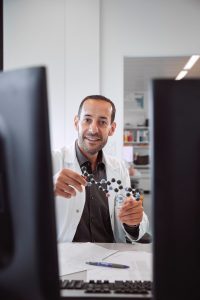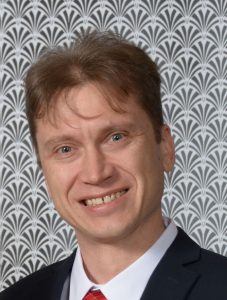Expertise in RNA Biology at Core of PTC’s Formative Work With Evrysdi

[Editor’s Note: This is one in a series of articles about the discovery and development of Evrysdi, the newly approved disease-modifying therapy for spinal muscular atrophy (SMA), as well as the scope of SMA issues and treatments. Here, we spoke with leaders at PTC Therapeutics about the expertise, and expert help, that set it on the road to SMA’s first oral and at-home therapy.]
PTC Therapeutics’ expertise in RNA biology and fundamental “hard work” made possible Evrysdi (risdiplam), the newly approved oral small molecule that safely and effectively raises SMN protein levels bodywide in people with SMA.
In an interview with SMA News Today, Stuart Peltz, PhD, PTC’s co-founder and CEO, and Nikolai Naryshkin, PhD, the company’s vice president of biology and head of its SMA program, discussed the company’s initial steps in recognizing and developing Evrysdi, and reasons for the benefits it has shown in patients to date.
Evrysdi, the first at-home daily therapy for all SMA types, ages 2 months and older, was the result of a long-lasting collaboration between PTC, Roche (which acquired an exclusive worldwide license to the company’s SMA program in 2011), Genentech (a Roche subsidiary), and the SMA Foundation.
The beginning
SMA is caused by mutations in the SMN1 gene, resulting in low, to no, levels of SMN, a protein essential for motor neurons and muscle health, but also required by all types of cells and tissues.
A surprising and helpful rarity in the biological world is that humans, unlike other mammals, have a second SMN gene — SMN2 — that also contains instructions to produce SMN protein.
But a small genetic difference leads to alternative splicing, an event that removes part of the information needed to make a full-length, working SMN protein from most of SMN2’s messenger RNA molecules. (Messenger RNA, or mRNA, is derived from DNA and used as template for protein production.)
Finding ways around this SMN2 shortcoming was precisely what the SMA Foundation had in mind when it asked Peltz in 2004 if PTC would be interested in SMA research.
“We didn’t know SMA all that well, but we thought it was an important disease that we could do something about,” Peltz said, noting that the company’s mission always has been to develop treatments for “ultra-rare disorders.”
Peltz, who founded PTC in 1998, studied RNA biology as a graduate student and continued in that area as a professor at Rutgers University. He and others at his company were well aware of the potential of splicing, a post-transcriptional mechanism — one that regulates protein production after DNA’s genetic information has been translated into mRNA.
PTC, Peltz said, took its very name from this mechanism: its letters stand for Post-Transcriptional Control.
In 2004, PTC already was working on Translarna (ataluren), an RNA-targeted treatment that later became the first approved disease-modifying therapy for Duchenne muscular dystrophy in Europe.
Foundation officials saw in PTC a valuable partner, and the two began collaborating in June 2006. The company’s SMA program was led by Sergey Paushkin, an MD with post-doctoral work in SMA, until February 2009, when Paushkin left PTC to join the foundation. (He now is a vice president at Skyhawk Therapeutics.)
The foundation was “instrumental … by helping at whatever was needed,” from various preclinical and clinical tools to SMA natural history studies, Peltz said.
“But as important to this, I think, was really our unique relationship,” he added. “The combination of a great biology team, a great chemistry team — great discovery teams — and then discussions between us and the SMA Foundation.”
High-throughput screening
From the start, the goal was to develop an oral small molecule that could cross the blood-brain barrier and reach every other tissue.
“We wanted to create an orally available, small molecule designed to target SMN in the brain and peripheral tissues. In our view, this was non-negotiable,” Hasane Ratni, PhD, a medicinal chemist and expert scientist at Roche who also would work closely on Evrysdi’s development, said in a separate interview via email. “To discover an effective and water-soluble molecule … for an at-home administration option for people with SMA.”
The brain-blood barrier is a specialized membrane that protects the brain and spinal cord (the central nervous system, or CNS) from potential insults by preventing many molecules from entering via circulating blood. The central nervous system also is where motor neurons, which control movement, are found.
But “it’s almost incontrovertible that SMN levels are important and important in all tissue types,” Peltz said, noting that muscle growth, for instance, is “fundamentally different” in the absence of this protein.
Reports of non-neurological problems in babies and children who later show SMA’s hallmark symptoms are known, Naryshkin added, further supporting the idea that “multiple organs are affected.”
PTC initially looked at three different ways of boosting SMN2’s ability to produce a better SMN protein. Targeting SMN2 splicing “took off more rapidly, and we put all our efforts on that,” Peltz said.
The “hard work” began around 2005–06: high-throughput screenings to identify those parts of a molecule that could be optimized to create a more selective — meaning safer — and potent oral splicing modifier.
“We had to solve all of those problems, which we did,” Peltz said, emphasizing that “most people didn’t think that it was doable.”
By the time Roche joined, PTC had a list of small molecules from which to choose — and the tools to optimize them.
Real-world studies in all SMA types, ages
Evrysdi’s clinical testing would involve the broadest range of SMA patients in terms of age and disease severity to date — at the request of the SMA community, Peltz and Naryshkin said.
“If you look at the other [SMA] studies that were being done, they didn’t really look at what you call real-world patients,” Peltz said.
One of the first “truly exciting” trial observations came after four weeks of the therapy’s use, then known as risdiplam. SMN protein levels rose in patients to meet or exceed those found in age-matched healthy volunteers.
“It was really reassuring,” Naryshkin said, as these data highlighted that treatment was effectively targeting SMN2’s splicing and resulting in “therapeutic SMN levels” in people with all types of SMA.
As is expected, greater benefits were seen in babies treated in the first months of life — when motor neurons, non-renewing cells, die in the absence of SMN. But older patients with type 2 and 3 disease also showed either improvements or stabilization in their motor function.
Based on PTC’s experience in treating Duchenne, Peltz anticipates that gains realized through Evrysdi’s use “will become better and better over time.”
An ‘incredible journey’
PTC believes that Evrysdi’s systemic nature, its “great safety profile,” and its ease of use (a flavored daily liquid) all provide potential advantages over SMA’s two other disease-modifying therapies — Spinraza (by Biogen) and Zolgensma (by Novartis and AveXis).
While both Evrysdi and Spinraza target SMN2 splicing, they are molecularly and mechanistically different, Peltz said. And the long-term effectiveness of Zolgensma, a gene therapy that works by delivering a working copy of the SMN1 gene to cells, is being determined.
Spinraza does not have systemic effects, because it cannot cross the blood-brain barrier. Approved to treat all SMA types and ages, it is injected every four months directly into the fluid that bathes the central nervous system
Zolgensma is approved as a one-time intravenous (IV) infusion therapy for newborns and toddlers up to age 2. As an IV infusion it enters the bloodstream, but is reported to specifically target motor neurons.
Results of clinical studies into all three therapies, Naryshkin said, have made it “quite clear to us that systemically bio-distributed pharmacological agents have a benefit,” even in patients with more advanced disease.
“It’s been an incredible journey, both scientifically, intellectually, as well as emotionally,” he said. “Staying together and getting to this stage … is very rewarding.”
PTC “couldn’t be prouder,” Peltz added, to be “part of a solution to a disease and be part of that community.”










